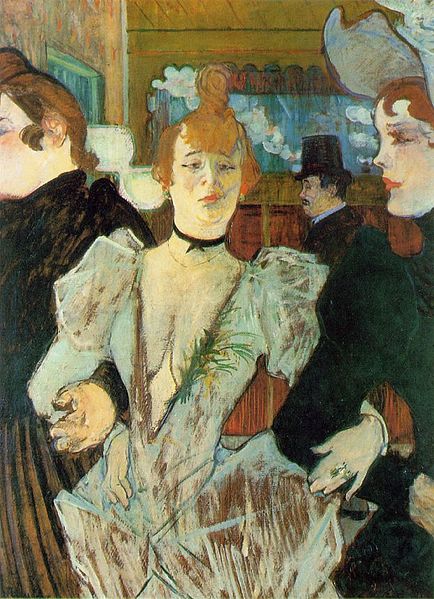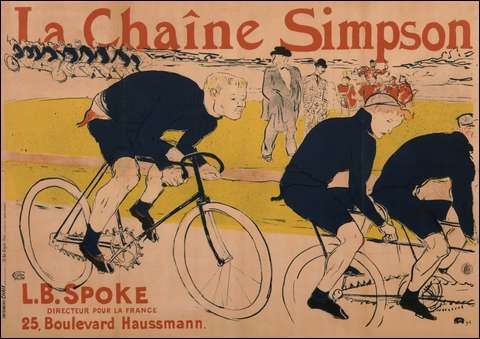Henri Toulouse-Lautrec brought the vivacity and energy of Parisian cabarets, café-concerts, and theater to life in his prints and posters, many of which were on display at the Cincinnati Art Museum in an exhibition entitled “Toulouse-Lautrec and the Spectacles of Paris” from October 13, 2012 through January 13, 2013. For the first time, the Art Museum displayed its entire collection of forty-three prints and eight posters, including the poster Cyclist Michael, which went through extensive conservation in order to be included in this exhibition.
Toulouse-Lautrec (1864-1901) was born into the aristocracy and received a classical education and academic art training. He came to artistic maturity as color lithography was gaining acceptance and posters were transforming the streets of Paris into outdoor art exhibitions. “Toulouse-Lautrec was a talented draftsman. Between 1891 and 1901 lithographic printmaking became central to his artistic output. His lithographs done directly on stone with crayon reflect his talent at capturing the essence of performers through their gestures and social persona on and off stage with humor,” says Kristin Spangenberg, Curator of Prints at the Cincinnati Art Museum. “He was one of the artists who raised the profile of the medium for artistic purposes as well as commercial purposes.”
Lithography because of it autographic nature and the introduction of the steam press made rapid production, multiple colors, and large scale lithographic printing ideal for advertising and commercial production. With the rise of the poster came the development of fine art printers with whom the artist collaborated. His posters integrating word and image bridged the gap between fine and commercial art. In the 1890s in addition to his awareness of the commercial value of his commercial work, Toulouse-Lautrec catered to a new class of bourgeoisie collectors by producing prints and posters before the addition of letters for the market. Over 120 years later, his surviving prints and posters still epitomize the spirit of fin de siècle Paris.
Visitors recognized great posters such as

Aristide Bruant in His Cabaret;

Jane Avril;
_1895.jpg/440px-Lautrec_la_revue_blanche_(poster)_1895.jpg)
La Revue Blanche;

and At the Concert,
the last of which is of particular interest since he created the poster for the Cincinnati firm of Ault & Wiborg Co.
Other great prints such as
_1895.jpg/456px-Lautrec_mademoiselle_marcelle_lender_(profile)_1895.jpg)
Mademoiselle Marcelle Lender, Half Length

and At the Moulin Rouge: La Goulue and Her Sister
were on display along with three of the ten plates from his series





Elles.
Viewers also saw Lautrec’s familiar portrayal of popular performers of his day to advertise entertainment, including

La Goulue;

Yvette Guilbert,

Aristide Bruant,

Sarah Bernhardt

and Marcelle Lender.
These performers were instantaneously recognized by his contemporaries.
From City Beat (images, link added):
Another familiar work is “The Jockey,” shown here in two states.
One is a first edition black and white,
the other five colors in the second state, second edition.
The jockeys stand in their stirrups, the foreshortened horses have all four feet off the ground, the tension and excitement are palpable. The label tells us that this late work (1899) reflects the artist’s youth on family estates in the south of France, where horses were a part of life, and underlines the fact that he came from an aristocratic background...
A lithograph, originally executed in olive green that has turned black with the years,
“Cyclist Michael” was commissioned by a bicycle company and shows a famous racer, Jimmy Michael, his trademark toothpick in his mouth, on a bicycle with a chain that could possibly power a locomotive. The chain is wrong, the company required a re-working:
but Toulouse-Lautrec for his own pleasure printed a few of these. This print required extensive conservation before it could be included here, but is a standout in the exhibition.
Toulouse-Lautrec was commissioned to do other commercial work besides posters, including song sheets, menus, book illustrations, and theater programs. He also published his own work. Edition sizes ranged from 25 to 100 and 2000 for the posters, all of which we have fine representative examples of in the collection. His posters with their bold typography, sweeping lines, brilliant colors, and startling patterns, reflect the influence of Japanese ukiyo-e prints.
More images:
Posters:

Ambassadeurs Aristide Bruant in his cabaret

Moulin Rouge: La Goulue

